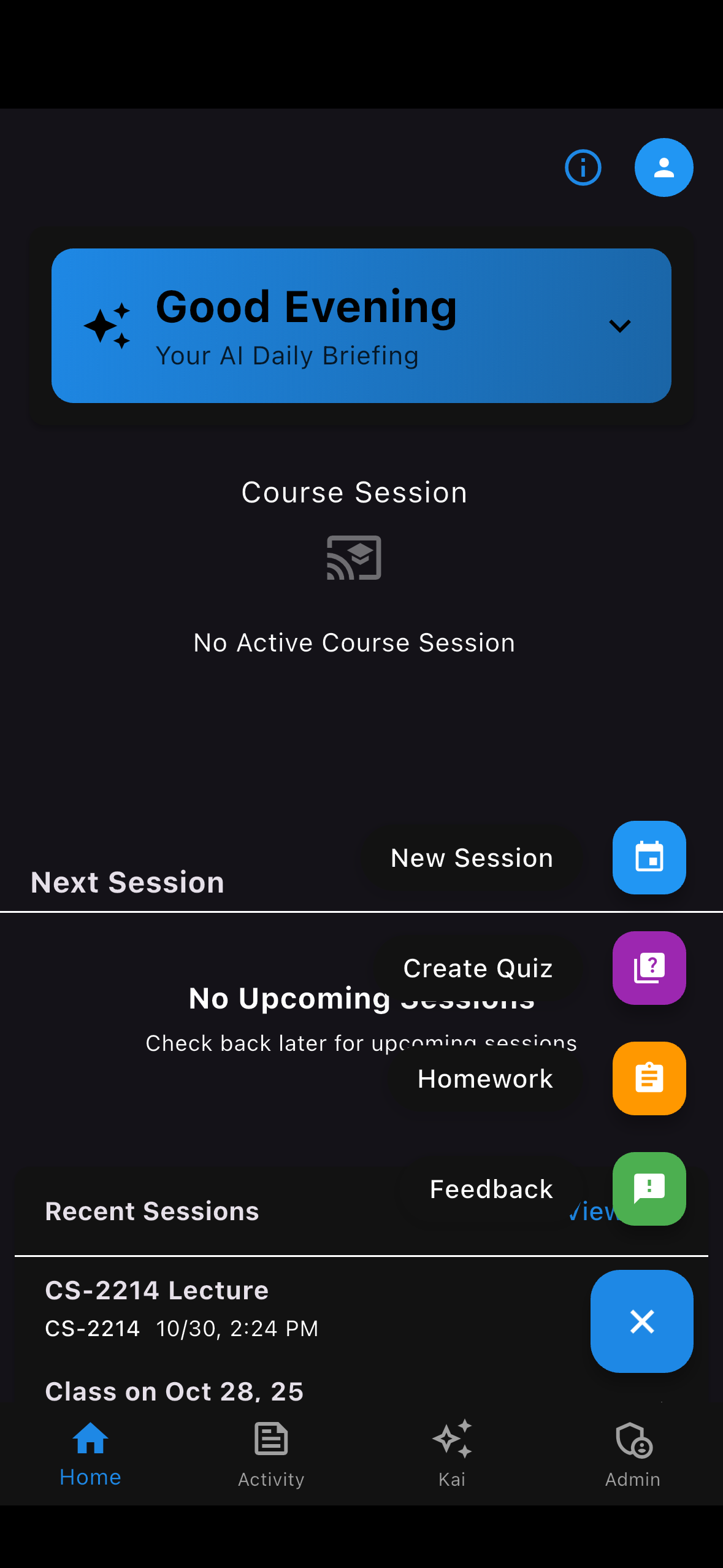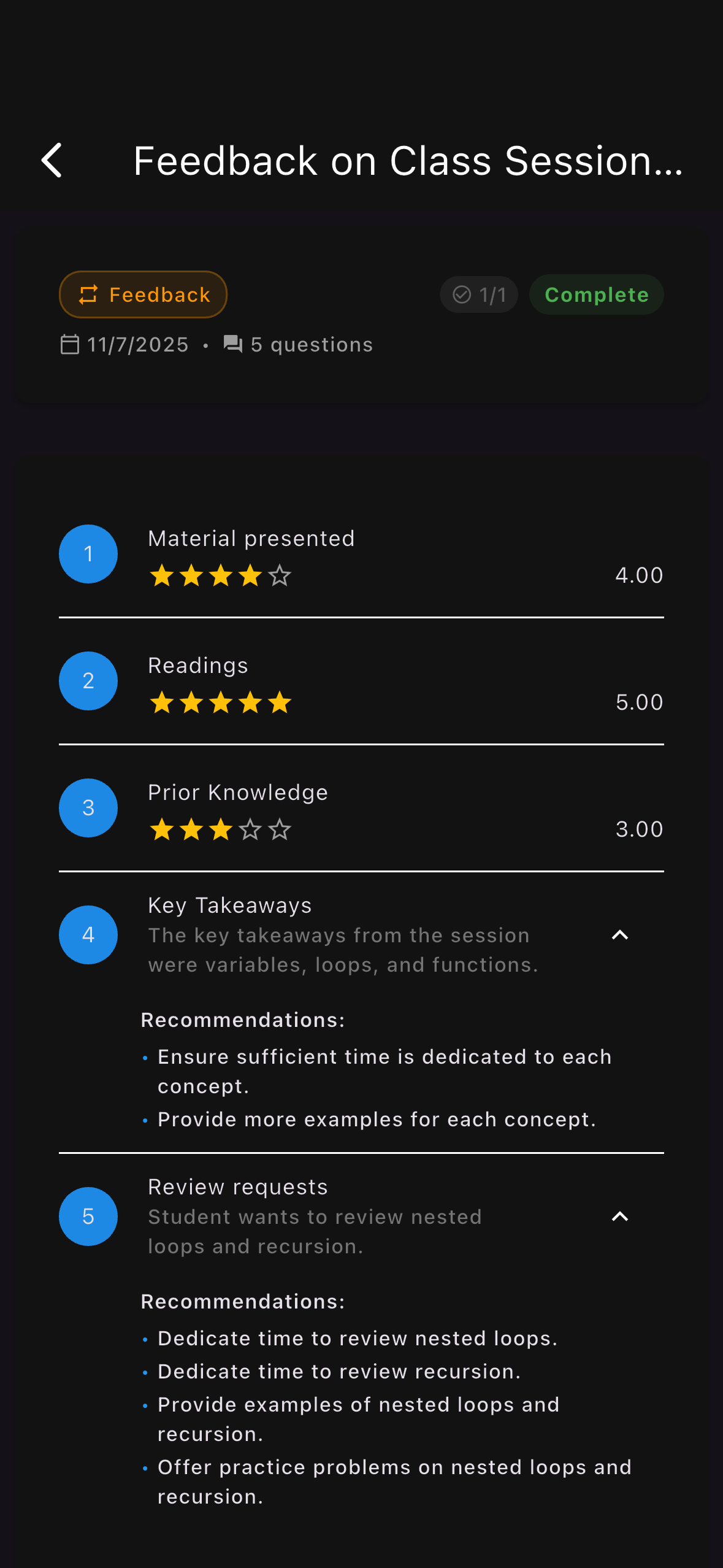Overview
The Feedback Workflow is incredibly simple: One click gets you instant student insights. While you teach, Kai monitors the class progress. With a single button press, you request feedback from students, and within moments you know exactly what they understood and what needs review. It’s that simple - no forms to create, no data to analyze manually.
How It Works
Just teach, click, and get insights - the entire process is automated:
graph LR
%% Teaching continues while Kai monitors
Teaching[Instructor<br/>Teaching] -.->|Kai monitors<br/>class time| Monitor[Kai Tracks<br/>Progress]:::kaibox
%% The simple ONE CLICK request
Teaching ==>|ONE CLICK| Request[Request<br/>Feedback]:::action
%% Automatic flow
Request --> Push[Push to<br/>Students]
Push --> Collect[Students<br/>Respond]
Collect --> Analyze[Kai Analyzes<br/>Responses]:::kaibox
%% Smart insights
Analyze --> Insights[Instant<br/>Insights]:::success
%% Adaptive teaching based on insights
Insights ==>|Real-time<br/>Guidance| Teaching
%% Decision based on frequency
Insights --> Adapt{Class Review<br/>or<br/>Individual?}
Adapt -->|Many Students| ClassReview[Review in Class]
Adapt -->|Few Students| Individual[Online Resources]
%% Both paths optimize teaching
ClassReview --> Teaching
Individual --> Teaching
%% Kai can also suggest when to ask
Monitor -.->|Suggests timing<br/>e.g. 50 min| Request
%% Styling - Consistent with style guide
classDef kaibox fill:#e3f2fd,stroke:#1976d2,stroke-width:2px,color:#000
classDef action fill:#ffeb3b,stroke:#f57c00,stroke-width:3px,color:#000,font-weight:bold
classDef success fill:#e8f5e9,stroke:#4caf50,stroke-width:2px,color:#000
classDef warning fill:#fff3e0,stroke:#ff9800,stroke-width:2px,color:#000
classDef neutral fill:#f5f5f5,stroke:#999,stroke-width:1px,color:#000
Student Feedback Workflow
- You Teach - Kai monitors class progress and timing
- You Click - One button requests feedback from all students
- You Get Insights - Instantly see what needs review vs. individual support
That’s it! No surveys to design, no data to crunch, just actionable insights.
Workflow Steps
1. Teaching and Recording
- Instructor conducts regular class session
- Kai monitors class duration and engagement metrics
- Class is recorded for later review and analysis
2. Feedback Request Triggers
Two ways to initiate feedback:
- Kai-Initiated: Proactive recommendations based on:
- Time elapsed (e.g., “50 minutes have passed”)
- Content complexity indicators
- Student engagement metrics
- Instructor-Initiated: Manual request at any time through the app
3. Student Feedback Collection
- Push notifications sent to all enrolled students with the app
4. Intelligent Analysis
Kai analyzes feedback patterns:
- Frequency Analysis: Identifies commonly misunderstood topics
- Severity Assessment: Evaluates depth of understanding gaps
- Resource Allocation: Determines optimal teaching strategy
5. Adaptive Response
High-Frequency Issues (Many Students)
- Action: In-class review recommended
- Example: If 70% of students struggle with “standard error”
- Result: Instructor re-teaches concept to entire class
- Benefit: Efficient use of class time for maximum impact
Low-Frequency Issues (Few Students)
- Action: Individual online resources recommended
- Example: If 2 students struggle with “standard deviation”
- Result: Targeted students receive personalized content
- Benefit: Class time preserved for majority needs
See It In Action
The following screenshots demonstrate the instructor’s feedback workflow from request creation through analysis:
Step 1: Create Feedback Request
Step 2: Configure Questions
Implementation Tips
Choosing the Right Feedback Template
Kai comes with pre-built feedback templates designed for different use cases. The standard template (shown in the screenshots above) is an excellent starting point for most courses:
- 3 Star-Rating Questions: Quick quantitative assessment of comprehension
- 2 Open-Ended Questions: Qualitative insights into student understanding
Why Open-Ended Questions Matter: While star ratings provide quick metrics, open-ended questions reveal the specific concepts causing confusion. This allows Kai to provide targeted recommendations rather than generic suggestions.
Template Consistency for Longitudinal Analysis
Pro Tip: Using the same or similar templates throughout your course enables powerful trend analysis over time. When Kai has consistent data points to compare, it can:
- Track improvement on specific topics across multiple sessions
- Identify persistent knowledge gaps that need additional attention
- Measure the effectiveness of your teaching interventions
- Show students measurable progress in their comprehension
Example: If you use the standard template after every lecture, Kai can show you that “student understanding of regression analysis improved from 2.3★ to 4.1★ after the in-class review” - actionable insights that inform your teaching strategy.
Best Practices for Instructors
- Start with Standard Template: Use Kai’s default 3-star + 2-open template for your first few sessions
- Regular Feedback Intervals: Don’t wait until the end of class - request feedback at natural transition points
- Act on Feedback Quickly: Address high-frequency issues in the same class session when possible
- Communicate Actions: Let students know their feedback was heard and how you’re responding
- Monitor Trends: Review Kai’s longitudinal analysis to track improvement over multiple sessions
- Customize Gradually: Once comfortable, customize templates for specific topics while maintaining core consistency
Student Engagement Strategies
- Incentivize Participation: Recognize students who provide helpful feedback
- Keep It Simple: Quick, easy-to-complete forms increase response rates
- Show Impact: Demonstrate how feedback shapes the class in real-time
- Provide Options: Mix star ratings (fast) with open-ended questions (detailed)
- Close the Loop: Share aggregate results showing how the class is progressing
Benefits
For Instructors
- 🎯 Targeted Teaching: Focus on concepts that need the most attention
- ⏰ Time Optimization: Efficient allocation of limited class time
- 📊 Data-Driven Decisions: Real-time insights into student comprehension
- 🔄 Immediate Adaptation: Adjust teaching on-the-fly based on feedback
For Students
- 📚 Personalized Learning: Individual support for specific needs
- 👥 Collective Voice: Class-wide issues addressed promptly
- 🚀 Accelerated Understanding: Immediate clarification of confusion
- 💡 Active Participation: Direct input into learning process
For Educational Outcomes
- 📈 Improved Comprehension: Targeted interventions where needed
- 🎓 Higher Success Rates: No student left behind approach
- 🔧 Resource Efficiency: Optimal use of instructor and online resources
- 📊 Measurable Impact: Track improvement through feedback loops
Technical Requirements
- Instructor App: Installed and configured
- Student App: Distributed to all enrolled students
This adaptive feedback system ensures that every minute of class time is optimized for maximum learning impact, while no student is left behind through personalized online support.


